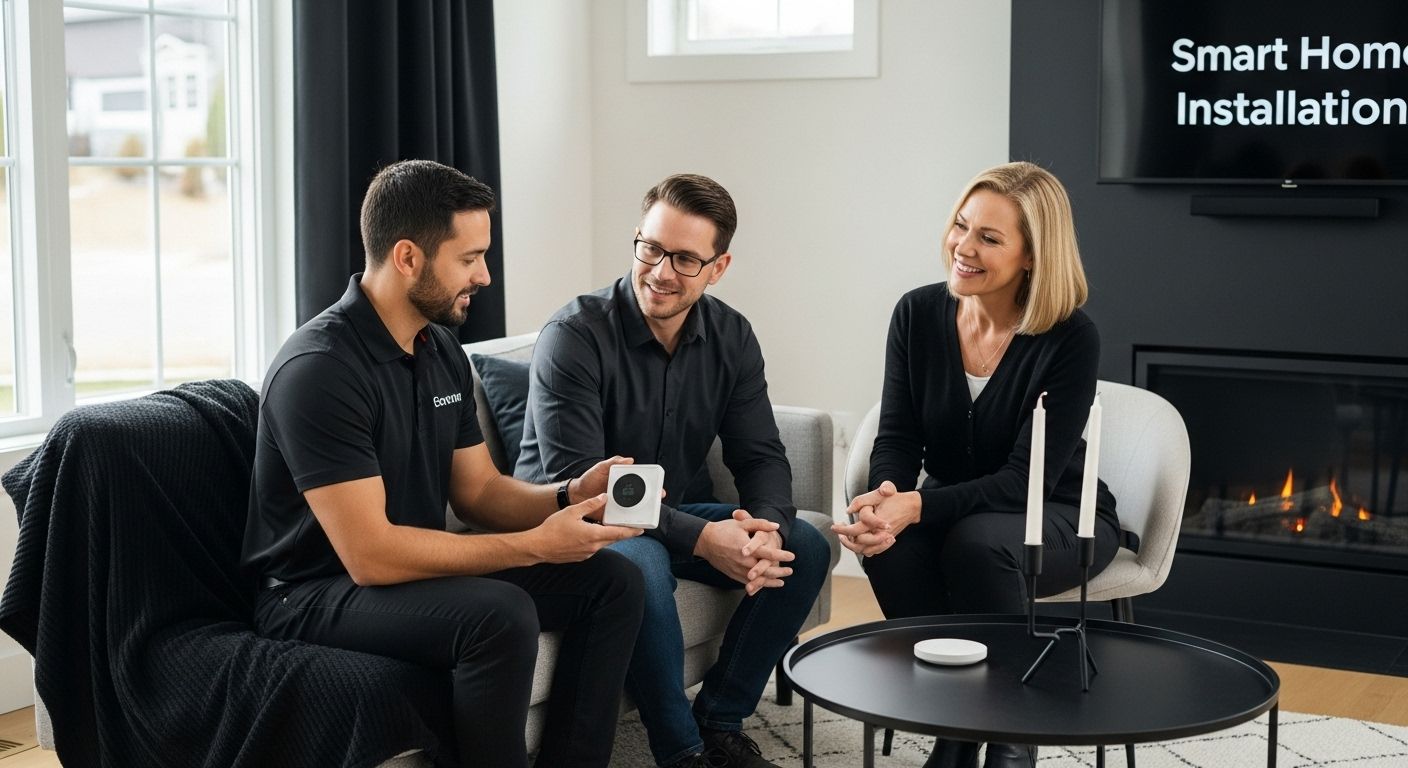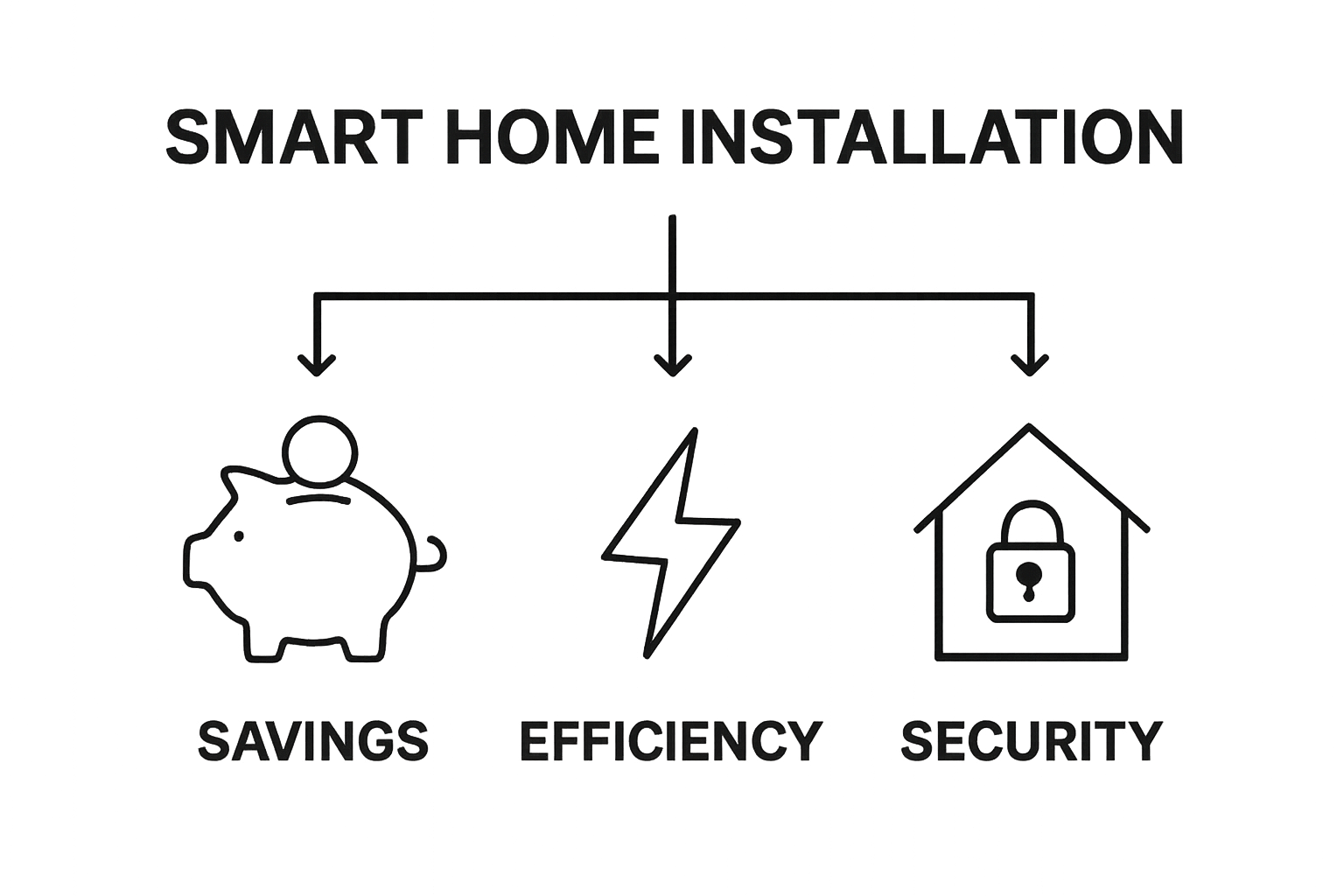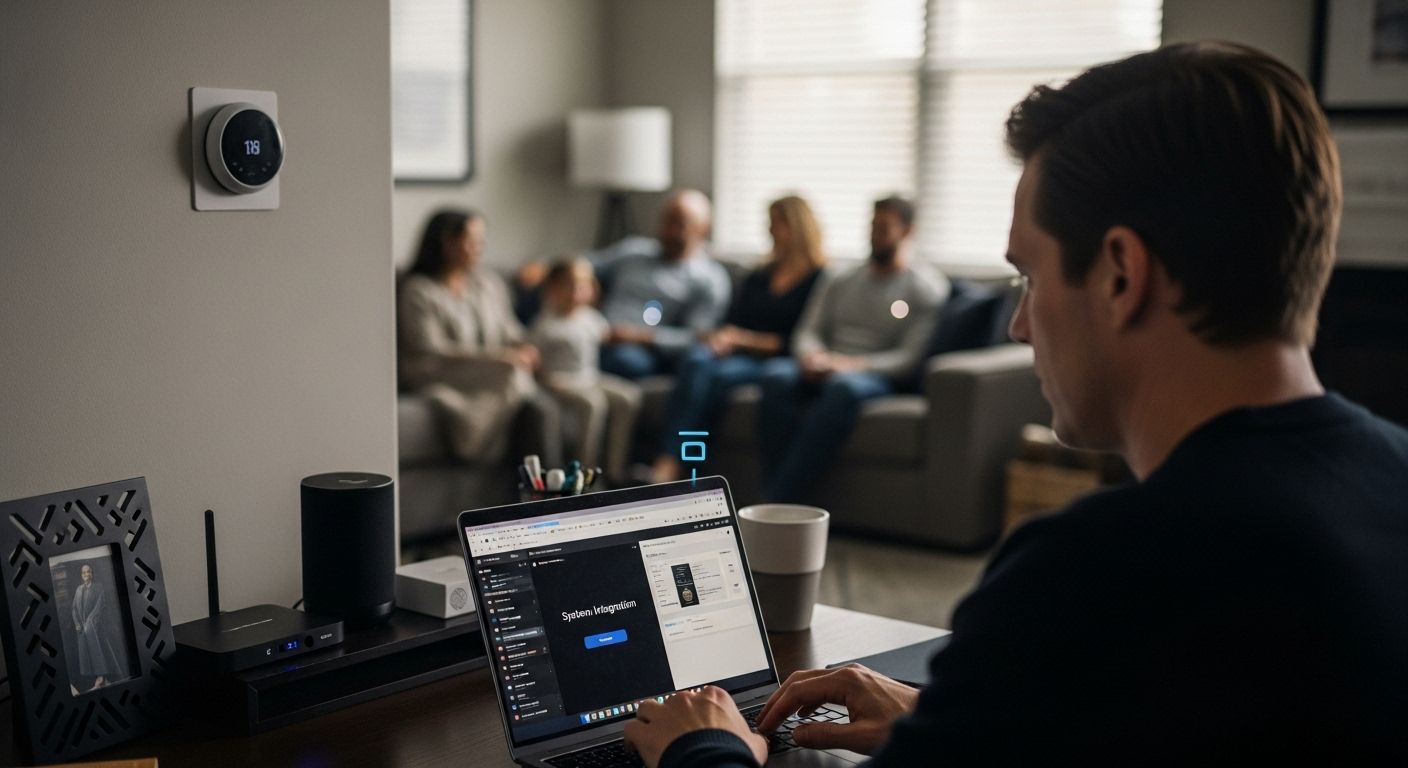Understanding the Smart Home Installation Process
- garygarihanjr
- Sep 2
- 8 min read

Smart home technology is turning ordinary houses into intelligent spaces that react to your lifestyle. More than 60 million American homes now use some kind of smart device and the number keeps climbing every year. People expect flashy gadgets or robots taking over but the quiet revolution is actually in day-to-day living. Small changes like automated lighting or energy-saving thermostats are saving families real money and making life easier in ways most never imagined.
Table of Contents
Quick Summary
Takeaway | Explanation |
Smart homes boost energy efficiency | Automated systems can lower energy consumption by optimizing usage and controlling appliances effectively. |
Enhanced security through real-time monitoring | Smart home technology allows homeowners to monitor their property remotely and receive alerts about potential security issues. |
Increased comfort with personalized settings | Home systems can adapt lighting, temperature, and entertainment preferences automatically based on user behavior and preferences. |
Higher property value from smart features | Installing smart devices may increase a home’s appeal to modern buyers, leading to potentially higher property values. |
Support for health and safety needs | Smart home technologies can provide critical health monitoring and emergency alerts for improved safety, especially for vulnerable individuals. |
What is Smart Home Technology and Its Benefits?
Smart home technology represents a revolutionary approach to residential living, transforming traditional houses into intelligent, interconnected environments that respond to homeowners’ needs with unprecedented efficiency and convenience. By integrating advanced digital systems and network-connected devices, smart homes enable automated control and monitoring of various household functions.
Understanding Smart Home Core Concepts
At its fundamental level, smart home technology involves creating a network of devices and systems that communicate with each other through internet connectivity.
These interconnected devices can be controlled remotely via smartphones, tablets, or voice-activated assistants, allowing homeowners to manage everything from lighting and temperature to security and entertainment systems with remarkable ease.
According to research from the National Center for Biotechnology Information, smart home technologies offer substantial benefits across multiple domains:
Energy Efficiency: Automated systems can significantly reduce energy consumption
Enhanced Security: Real-time monitoring and remote access control
Operational Convenience: Simplified management of home systems and appliances
Practical Applications and Transformative Potential
The real power of smart home technology lies in its ability to create personalized, responsive living environments. Imagine walking into your home, and lights automatically adjust to your preferred brightness, temperature settings adapt to your comfort, and your favorite music starts playing seamlessly. These aren’t futuristic fantasies but current realities made possible by smart home integration.
For homeowners seeking to understand more about optimizing their living spaces, our comprehensive guide on home automation provides deeper insights into transforming residential experiences through intelligent technology. Whether you’re interested in energy savings, increased security, or simply creating a more convenient lifestyle, smart home technology offers a compelling solution to modern living challenges.
Why Smart Home Installation is Important for Homeowners
Smart home installation represents more than just a technological upgrade. It is a strategic investment that transforms residential living by enhancing comfort, efficiency, and overall quality of life. Homeowners are increasingly recognizing the multifaceted benefits that come with integrating intelligent systems into their living spaces.
Economic and Operational Advantages
The financial implications of smart home technology extend far beyond initial installation costs. According to the U.S. Environmental Protection Agency’s ENERGY STAR program, smart home devices can generate substantial energy savings through automated and intelligent management of household systems. Intelligent thermostats, lighting controls, and appliance management can reduce energy consumption by up to 30%, translating into significant long-term cost reductions.

Key economic benefits include:
Reduced Energy Expenses: Automated systems optimize energy usage
Increased Property Value: Smart home features attract modern buyers
Lower Maintenance Costs: Predictive maintenance alerts prevent expensive repairs
Enhanced Living Experience and Personal Security
Beyond financial considerations, smart home installations provide unprecedented levels of personal comfort and security. Modern systems allow homeowners to create personalized environments that adapt to individual preferences. Temperature, lighting, and entertainment systems can be configured to respond automatically to occupancy, time of day, or specific user preferences.
Security represents another critical dimension of smart home technology. Advanced systems offer real-time monitoring, remote access control, and instant alerts for potential security breaches. These features provide homeowners with peace of mind and a sense of comprehensive protection.
Learn more about advanced home security integration to understand how these technologies can transform your living environment. Smart home installations are not just about technological novelty but about creating intelligent, responsive spaces that enhance your lifestyle and protect your most valuable asset.
How Smart Home Systems Communicate and Integrate
Smart home systems represent a complex ecosystem of interconnected devices that communicate through sophisticated networking technologies. Unlike traditional standalone appliances, these intelligent systems create a seamless, integrated environment where devices can exchange information, respond to user commands, and adapt to changing household conditions.
Communication Protocols and Network Infrastructure
According to the National Institute of Standards and Technology, smart home devices utilize multiple communication protocols to enable interaction. These protocols serve as the fundamental language through which different devices understand and respond to each other.
Below is a table comparing the main smart home communication protocols discussed in the article, highlighting their unique characteristics and recommended use cases.
Protocol | Key Characteristics | Typical Use Cases |
Wi-Fi | High bandwidth, long range | Streaming, internet-connected devices |
Zigbee | Low power, mesh network, reliable | Home automation sensors |
Z-Wave | Low power, mesh network, secure | Home security, device control |
Bluetooth Low Energy | Energy efficient, short range, low latency | Proximity-based interactions, accessories |
Common communication standards include Wi-Fi, Zigbee, Z-Wave, and Bluetooth Low Energy, each offering unique advantages for specific types of device connectivity. |
Key communication protocols have distinct characteristics:
Wi-Fi: High-bandwidth, long-range communication for streaming and internet-connected devices
Zigbee: Low-power, mesh network protocol ideal for home automation sensors
Z-Wave: Specialized protocol for home security and control systems
Bluetooth Low Energy: Energy-efficient communication for proximity-based interactions
Integration Platforms and Central Control
Modern smart home systems leverage central integration platforms that act as digital orchestrators, enabling diverse devices from different manufacturers to work together harmoniously. These platforms, such as Apple HomeKit, Google Home, and Amazon Alexa, provide a unified interface where homeowners can configure, monitor, and control multiple smart devices through a single application.
Explore our comprehensive guide to smart home automation to understand how these integration platforms transform disconnected devices into a cohesive, intelligent home ecosystem. The true power of smart home technology lies not just in individual device capabilities, but in their ability to communicate, coordinate, and create responsive living environments that anticipate and fulfill homeowner needs.

Key Components of Smart Home Installation Explained
A successful smart home installation requires a strategic combination of hardware, software, and networking technologies that work together to create an intelligent, responsive living environment. Understanding these critical components is essential for homeowners seeking to transform their traditional living spaces into advanced, interconnected systems.
Core Hardware Infrastructure
According to research from the National Center for Biotechnology Information, smart home systems comprise several fundamental hardware components that enable comprehensive home automation. These devices form the physical foundation of an intelligent home ecosystem, each serving specific functional roles in monitoring, controlling, and responding to household conditions.
Here is a table organizing the core hardware components of a smart home installation and their primary functions, as introduced in the article.
Component | Primary Function |
Central Control Hub | Acts as command center for all devices |
Smart Sensors | Detect environmental changes and occupancy |
Connected Devices | Perform tasks (e.g., thermostats, lighting, security cameras) |
Network Router | Provides internet and device connectivity |
Key hardware components include:
Central Control Hub: Serves as the brain of the smart home system
Smart Sensors: Detect environmental changes and occupancy
Connected Devices: Thermostats, lighting systems, security cameras
Network Routers: Provide robust internet connectivity
Software and Integration Platforms
The software layer represents the intelligence behind smart home systems, enabling devices to communicate, make decisions, and adapt to homeowner preferences. Advanced integration platforms transform individual devices into a cohesive, responsive network that can be controlled through smartphone applications or voice-activated assistants.
Modern smart home systems leverage sophisticated algorithms that learn from user behavior, automatically adjusting settings to optimize comfort, energy efficiency, and security. These platforms enable complex interactions between different devices, creating seamless automation scenarios that anticipate and fulfill household needs.
Discover more about advanced home automation strategies to understand how these intricate systems can revolutionize your living experience. The true potential of smart home technology lies not just in individual device capabilities, but in their ability to work together as an intelligent, adaptive ecosystem.
Real-World Applications of Smart Home Solutions
Smart home solutions have transcended technological novelty, emerging as practical tools that dramatically enhance daily living across multiple domains. These sophisticated systems offer more than convenience, providing tangible improvements in safety, efficiency, energy management, and personal comfort through intelligent technological integration.
Health and Safety Innovations
According to research published in JMIR Mhealth Uhealth, smart home technologies are increasingly designed to support individuals with diverse health and accessibility needs. Advanced systems can monitor environmental conditions, detect potential medical emergencies, and provide real-time alerts to caregivers or healthcare professionals.
Key health and safety applications include:
Medical Monitoring: Tracking vital signs and movement patterns
Emergency Detection: Automatic alerts for falls or unusual activity
Accessibility Support: Adaptive environments for individuals with mobility challenges
Remote Caregiver Notifications: Instant communication about potential health risks
Energy Management and Sustainability
Smart home solutions play a critical role in creating more sustainable living environments by optimizing energy consumption and reducing unnecessary waste. Intelligent systems can learn household patterns, automatically adjust heating and cooling, and provide detailed insights into energy usage, enabling homeowners to make more environmentally conscious decisions.
Modern smart home technologies integrate sophisticated sensors and machine learning algorithms that can predict and adapt to changing environmental conditions. These systems go beyond simple temperature control, offering comprehensive energy management strategies that can significantly reduce household carbon footprints and utility expenses.
Explore our comprehensive guide to home automation strategies to understand how these advanced technologies can transform your living experience. Smart home solutions represent more than technological innovation they are powerful tools for creating more responsive, efficient, and personalized living environments.
Ready to Experience a Seamless Smart Home Installation?
Are you feeling overwhelmed by the complexity of smart home integration or unsure how devices, communication protocols, and automation platforms tie together in your unique living space? You are not alone. Many homeowners want the benefits of energy efficiency, enhanced security, and ultimate convenience, but struggle with the uncertainty and technical details described in our article. Your home deserves an expert touch that brings together all these concepts into one intelligent system.

Why wait to simplify your life and elevate your home? The specialists at Techology Experts turn your vision into reality with custom installations using top-tier smart systems like Control4. Our professional automation service makes sure every device, hub, and platform works together effortlessly. Don’t miss out on creating a living space that is truly responsive and secure. Contact us today for a personalized consultation and let us show you how simple and satisfying a premium smart home installation can be.
Frequently Asked Questions
What components are essential for a smart home installation?
A smart home installation typically requires a central control hub, smart sensors, connected devices (like thermostats and security cameras), and a reliable network router. These components work together to create an integrated system.
How do smart home devices communicate with each other?
Smart home devices communicate through various protocols, including Wi-Fi, Zigbee, Z-Wave, and Bluetooth Low Energy. These protocols enable seamless interaction and coordination between devices in the ecosystem.
What are the benefits of energy management through smart home technology?
Smart home technology optimizes energy consumption by learning household patterns and automatically adjusting systems like heating and cooling. This leads to substantial energy savings and reduced utility costs over time.
How does smart home technology enhance personal security?
Smart home technology enhances personal security by offering features such as real-time monitoring, remote access control, and instant alerts for suspicious activities. This allows homeowners to maintain a higher level of safety and peace of mind.
Recommended
Comments